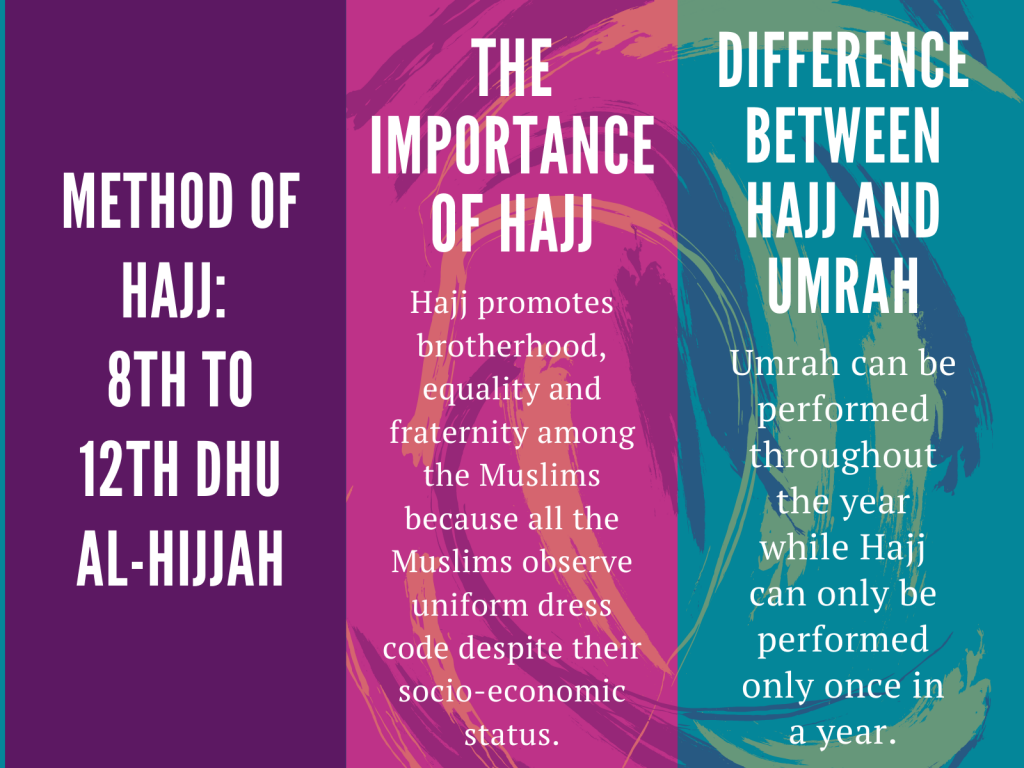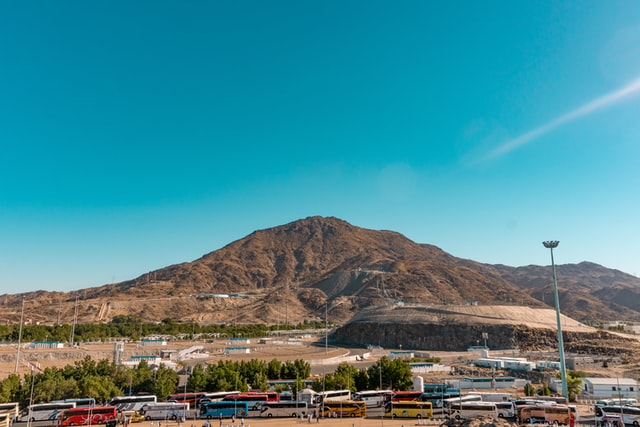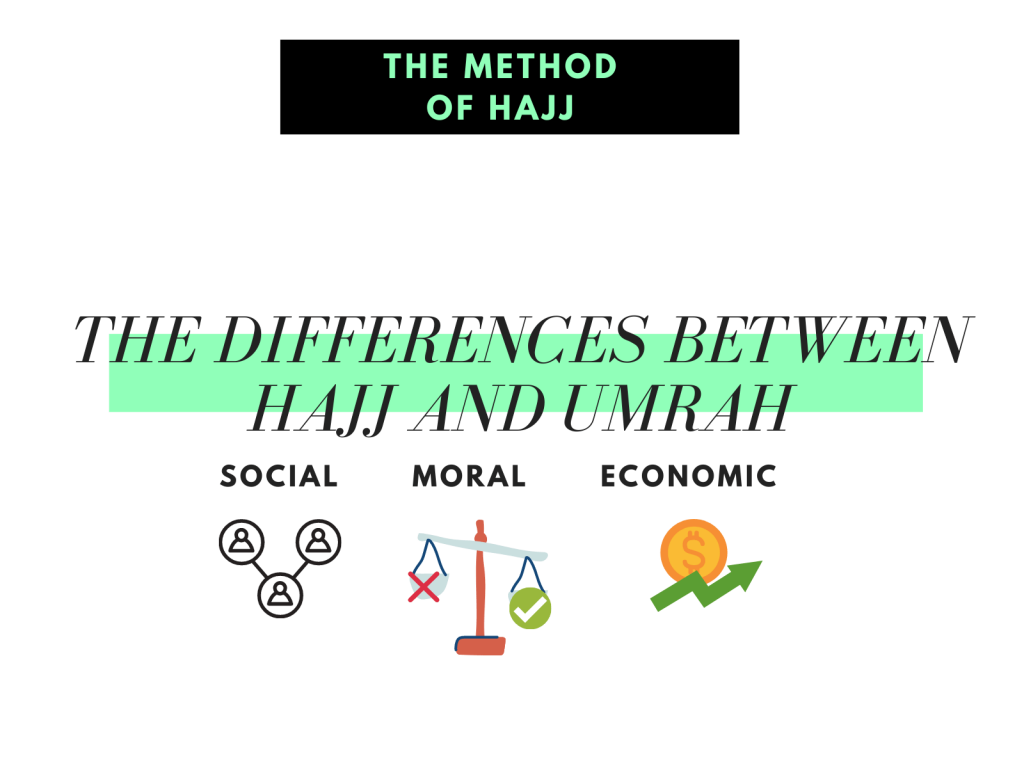
Hajj is the fifth pillar of Islam but it is only obligatory upon those Muslims who are financially and physically capable and who are not oppressed by a tyrant ruler.
The Holy Quran clearly instructs the Muslims to perform hajj if they satisfy all the required conditions. The Quran says:
Pilgrimage thereto (the Ka’aba) is a duty men owe to Allah, those who can afford the journey.
Al-Quran (Surah Al-e-Imran 3:97)
Now, let’s discuss the method of hajj and the relating events without any further introductions.
How to Perform Hajj?
Hajj is observed from 8th to 12th Dhul Hijjah (it is the 12th month of the lunar calender).
Ihram:
Firstly, the people who intend to perform Hajj have to put on their ihram. This is the dress code which indicates the niyat (intention) of someone to perform either Umrah or Hajj.
The Ihram of the men are the two sheet of clothes. One sheet of cloth covers to upper part of their body while the second covers the lower part of their body.
The Ihram for women is their everyday dress. However, the women have to cover their entire body except for their hands, feet and face. After putting on their dresses, both male and female make the intention of performing Hajj.
When one enters the state of Ihram, they have to continuously recite Talbia. It is an expression of submission and gratitude to God. Although it is recited in Arabic, the meaning is mentioned below:
At Your service, Allah, at Your service. At Your service, You have no partner, at Your service. Truly all praise, favour and sovereignty is Yours. You have no partner.
When a soul enters the state of Ihram, there are certain restrictions of Ihram. Some of them are listed below:
- Cutting of nails and hairs is not allowed
- Putting on perfume on Ihram is also not allowed
- Men cannot cover their heads and face
- The killing of insects is also not allowed (harmful insects can be killed)
- Violence cannot be committed
- Use of soaps and shampoo is prohibited (due to odour)

8th Dhul Hijjah:
On 8th of Dhu al-Hijjah, the pilgrims move to Makkah in order to perform Tawaf-e-Qudoom. During this, one has to circumambulate around the Holy Ka’ba seven times.
Then, two Raka’at of prayer is performed behind the station of Ibrahim as the Quran says:
And take you the station of Abraham as a place of prayer
Al-Quran (Surah Baqarah 2:125)
After that, the Muslims perform Sai, the movement between the Safa and the Marwa hills seven times.This marks the completion of the Tawaf-e-Qudoom.
Behold! Safa and Marwa are among the symbols of God…
Al-Quran (Surah Baqarah 2:158)
After the Tawaf-e-Qudoom, the pilgrims move to the plains of Mina on the same day (8th of Dhul Hijjah). In Mina, the pilgrims offer five prayers. The five prayers are:
- Zuhr (8th Zil Hajj)
- Asr (8th Zil Hajj)
- Maghrib (8th Zil Hajj)
- Isha (8th Zil Hajj)
- Fajr (9th Zil Hajj)
In Mina, the pilgrims keep themselves busy in worship and they seek mercy and forgiveness of God. At the same time, Talbia is continually recited as well.
Related: Isra Wal Mi’raj (621 A.D) | GCE O Level | Best Notes
9th Dhul Hijjah:
After the offering of the Fajr prayer of the 9th of Zil Hajj, the pilgrims move towards Arafat. The stay at Arafat is the most important part of the pilgrimage, this stays in Arafat is known as Wuquf-e-Arafat.
In Arafat, the Muslims listen to the sermon delivered by the Imam and then they offer the prayer of Zuhr and Asr combined (zohrain). Moreover in Arafat, the Muslims pray for their forgiveness as it is proved that this is the time when Allah forgives his people.
Fasting on the day of Arafat is prohibited for the pilgrims but it is highly recommended for non-pilgrims in order to attain massive reward.

According to a Hadith of Prophet Muhammad (PHUH), pilgrimage is the Day of Arafat.
It is among the method of Hajj that at sunset, the pilgrims move towards Muzdalifa, a place located between Arafat and Mina, where they have to spend the night of 9th of Zil Hajj. It is to note that the pilgrims move without offering the Maghrib prayer, why?
This is because when the pilgrims arrive in Muzdalifa, they offer the Maghrib and the Isha prayer combined. This is known as Maghribain. The Holy Quran says:
Then when you pour down from Arafat, celebrate the praises of God at the Sacred Monument (Muzdalifa).
Al-quran (surah baqarah 2:198)
During this stay, the Muslims continually seek the mercy and forgiveness of their lord. Similarly, the keep themselves busy in worship and private prayer (Dua).
10th Dhul Hijjah:
The pilgrims offer the Fajr prayer of the 10th of Dhul Hijjah in Muzdalifa. What happens next?
After the Fajr prayer, the pilgrims collect 49 pebbles from here for the stoning of the Jamarat (Rami).
On 10th of Zil Hajj, the Muslims perform sacrifice and the male shave off their head or cut their hairs short while the women also shorten their hairs.
On the same day, the pilgrims stone the largest pillar. The largest pillar is known as the Jamarah al-Aqaba (the big pillar). This is known as the stoning of the devil. The other two pillars are:
- Jamarah al-Wusta (the medium pillar)
- Jamarah al-Sugra (the small pillar)
11th and 12th Dhul Hijjah:
On the other two days, 11th and 12th of Zil Hajj, the Muslims pelt all three pillars with stones. This action reminds the Muslims about the Satanic attempts to misguide Hazrat Ibrahim who remained steadfast and instead rejected Satan.
After this, the pilgrims have to perform the Tawaf-e-Ziyara. This is one of the most important parts of Hajj.
Also Read: Relationship Between Quran And Sunnah | Best Notes
In Tawaf-e-Ziyarat, the pilgrims move towards Makkah. They circumambulate around the Ka’ba seven times (perform Tawaf). After that, they perform two Raka’at behind the station of Ibrahim and this is followed by Sa’i (movement between Safa and Marwa hills). This Tawaf can be performed anytime during 10th to 12th Dhul Hijjah.
The Importance of Hajj:

Hajj is a very significant event for the Muslims and there are several reasons for that. Some of the reasons are listed below:
- Hajj promotes brotherhood, equality and fraternity among the Muslims because all the Muslims observe uniform dress code despite their socio-economic status.
- Hajj is a source of success in the world and hereafter because the Muslims come closer to God and they seek His mercy and forgiveness.
- The Muslims come across their Holy places such as the Ka’ba and the plain of Arafat (where the Muslims will summon on the day of judgement).
- Hajj negates racism because all of the Muslims offer their rituals in the congregation despite their culture, race and colour.
Apart, Hajj is also important as it is a pillar of Islam and a compulsory act for those people who fulfil its requirements. Moreover, Hajj allows Muslims to remind the sermon of the Prophet Muhammad (PBUH) during his farewell pilgrimage. In the sermon, the Prophet (PBUH) stressed upon important matters.
Due to the stoning of the devil, the Muslims remind themselves that they are equally vulnerable before Satan. Similarly, Rami allows Muslims to understand the fact that Satan is indeed an open enemy of man as the Quran clearly states that.
Furthermore, Hajj is also important because when the pilgrims observe certain restrictions of the Ihram, they become capable of observing rules and regulations in their life.
These practices allow Muslims to shape their life.
Hajj refreshes the knowledge of Muslims because they visit several sacred places during Hajj such as Arafat, Mina and Muzdalifa.
In terms of economic advantages, Hajj ensures trade which stimulates the economic activities and the visit of the pilgrims is a source of income.
This is permitted in Islam as it is proved by several Ahadith and Quranic passages.
This takes us to another very important topic which is the difference between Hajj and Umrah. So, let’s discuss the question.
The difference between Hajj and Umrah:
There are several differences between Hajj and Umrah. Some of them are:

- Umrah can be performed throughout the year while Hajj can only be performed only once in a year.
- Hajj is obligatory (for some people) while Umrah is not.
- The reward for Hajj is greater than that of Umrah.
- There are three types of Hajj (Qiran, Ifrad and Tamattu) while there are two types of Umrah (Umrah tul Mufradah and Umrah tul Tamattu).
- There is no sacrifice (Qurbani) in Umrah while the people performing Hajj have to perform a sacrifice (Qurbani).
With this, the topic regarding the differences between Hajj and Umrah have been summarized.
Conclusion:
With this, the notes regarding the method of Hajj has come to an end. I hope that all your queries have been answered.
Hajj is a very important event for the Muslims and since it is a pillar of Islam, it is mandatory upon all those Muslims who are sound of mind, financially and physically capable and they are not oppressed by a tyrant ruler.
Thank You very much for reading this article regarding Hajj and the important events related to it.
